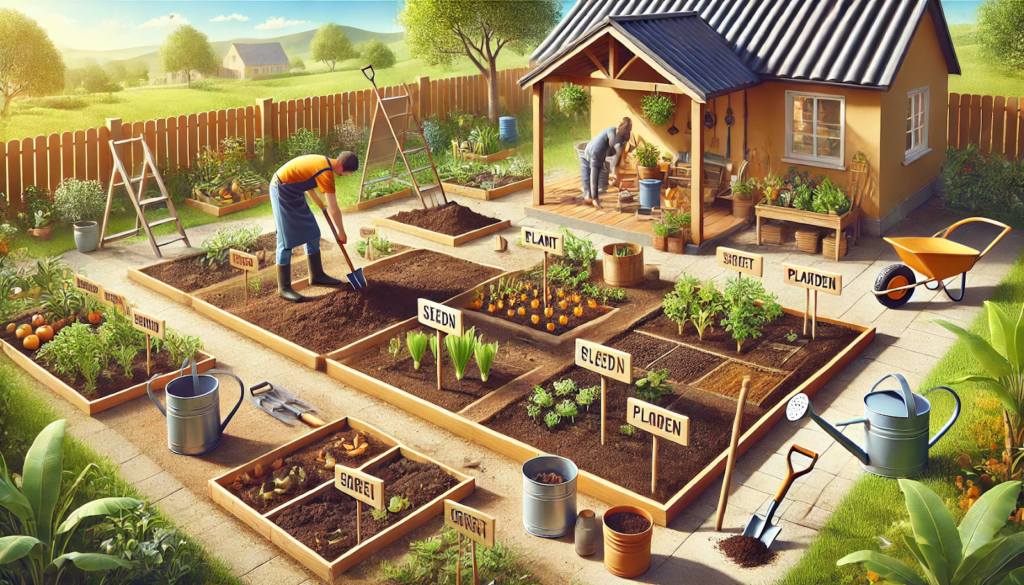Creating a home garden from scratch can be one of the most fulfilling projects you undertake. Whether you want to grow your own vegetables, herbs, or flowers, starting from zero gives you full control over the design, layout, and the types of plants you cultivate. This guide will walk you through every essential step needed to successfully begin a home garden, even if you have no prior experience.
Step 1: Evaluate Your Space
Before you plant anything, evaluate the space available. Consider:
- How much sunlight it receives daily
- Whether it has access to water
- The type of soil present
- If it is prone to wind or shade
For small spaces like balconies or patios, container gardening or vertical gardens are excellent solutions. If you have a backyard, choose a flat, open area that gets at least 6 hours of direct sunlight per day.
Step 2: Choose the Type of Garden
Determine what kind of garden you want. This choice affects everything from soil preparation to plant selection. Common types include:
- Vegetable garden: Requires sunlight and fertile soil.
- Herb garden: Perfect for small areas and kitchen use.
- Flower garden: Adds color and beauty to your outdoor space.
- Mixed garden: Combines vegetables, herbs, and flowers.
Knowing your goal from the beginning will help you stay focused and make better decisions during setup.
Step 3: Plan Your Layout
Sketch a simple layout of your garden on paper. Think about:
- Pathways and walking space
- Raised beds or traditional rows
- Space between plants for growth
- Location of tall vs. short plants (to avoid shading)
A well-planned layout ensures optimal plant spacing, easier maintenance, and better aesthetic appeal.
Step 4: Test and Prepare the Soil
Healthy soil is crucial for a thriving garden. Use a soil test kit to check pH and nutrient levels. Most vegetables prefer slightly acidic to neutral soil (pH 6.0–7.0). If needed, amend the soil with:
- Compost
- Aged manure
- Organic matter (like leaf mold)
For areas with poor native soil, consider building raised beds and filling them with a quality soil mix.
Step 5: Select Your Plants
Choose beginner-friendly and climate-appropriate plants. Research your region’s USDA Hardiness Zone and opt for varieties that grow well in that climate.
For beginners, some easy-to-grow plants include:
- Tomatoes
- Basil
- Lettuce
- Marigolds
- Carrots
- Cucumbers
Consider planting a mix of fast-growing crops and slower-growing ones to maintain interest and yield throughout the season.
Step 6: Gather Essential Tools and Supplies
You don’t need an elaborate tool collection to start. Basic tools include:
- Hand trowel
- Garden gloves
- Watering can or hose with spray nozzle
- Pruners or scissors
- Rake and shovel (for larger spaces)
Other useful supplies might include mulch, plant labels, garden twine, and stakes.
Step 7: Start Planting
Read the instructions on each seed packet or plant label. Follow proper spacing, planting depth, and watering recommendations. When in doubt:
- Water the soil lightly before planting
- Sow seeds or place seedlings gently into the soil
- Pat down the soil without compacting it too much
- Water again after planting
Group plants with similar water and sunlight needs to make maintenance easier.
Step 8: Watering and Feeding
Consistent watering is key, especially in the first few weeks. Water early in the day to reduce evaporation and avoid disease. Check the soil regularly—plants should never sit in soggy soil, but they shouldn’t dry out completely either.
Use organic compost or liquid fertilizer every few weeks to keep plants nourished. Avoid over-fertilizing, which can burn plant roots.
Step 9: Mulch and Maintain
Apply a layer of mulch around plants to:
- Retain moisture
- Suppress weeds
- Regulate soil temperature
Organic mulches like straw, shredded leaves, or wood chips also improve soil quality over time.
Maintenance tasks include:
- Weeding weekly
- Pruning damaged or dead growth
- Checking for pests or signs of disease
- Supporting tall plants with stakes or cages
Step 10: Observe and Learn
Gardening is a continuous learning process. Keep a journal of what you plant, what works, and what doesn’t. Take note of weather patterns, watering habits, and plant health.
Be patient—some plants take weeks or even months to fully mature. Celebrate small successes and learn from challenges.
Growing Confidence: The Joy of Starting Fresh
Starting a home garden from scratch may seem intimidating at first, but every great garden begins with a single seed. With thoughtful planning, proper preparation, and a willingness to learn, you’ll build a space that brings beauty, nourishment, and peace to your everyday life. Over time, your garden will grow—not just in plants, but in your knowledge and passion as well.






